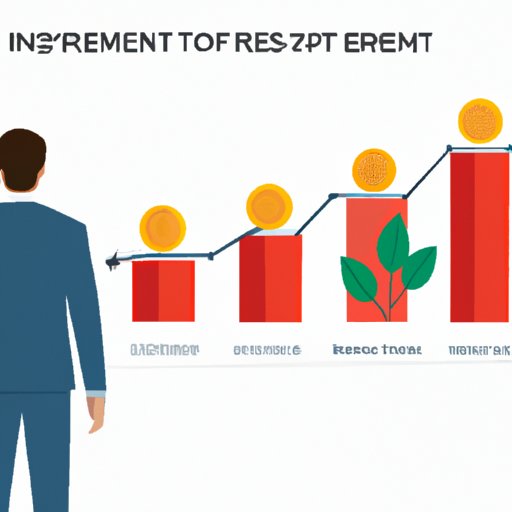Introduction
Return on Investment (ROI) is a key metric used in financial analysis to measure the performance of an investment. It is calculated by dividing the net profits earned from the investment by the total amount invested. ROI is expressed as a percentage and indicates whether or not an investment has been successful.
In this article, we will explore how to calculate return on investment and examine the different types of investments and their potential returns. We will also discuss the benefits of understanding how to calculate ROI and provide examples of real-world ROI calculations.

Explaining the Formula for Calculating Return on Investment
The formula for calculating return on investment is relatively straightforward:
ROI = (Net Profit/Total Investment) x 100
To calculate ROI, you need to know the net profit earned from the investment and the total amount invested. For example, if you invest $10,000 in a stock and earn a net profit of $2,000, your ROI would be 20%.
It’s important to note that ROI is calculated on a pre-tax basis. If you are taxed on your investment earnings, you need to factor that into the equation.

Outlining the Steps Involved in Calculating ROI
Calculating ROI requires several steps. First, you need to determine the total amount invested in the investment. This includes the cost of purchasing the asset, any fees associated with the purchase, and any other costs related to the investment.
Next, you need to calculate the net profit earned from the investment. This can be done by subtracting any expenses associated with the investment (such as taxes or commissions) from the total gains generated from the investment.
Finally, you can use the formula above to calculate the ROI. Simply divide the net profit by the total investment and multiply the result by 100 to get the ROI as a percentage.
Analyzing the Benefits of Knowing How to Calculate ROI
Knowing how to calculate ROI is an essential skill for investors. By being able to accurately calculate ROI, investors can compare the performance of different investments and make informed decisions about where to allocate their resources.
ROI is also a helpful tool for evaluating the success of an investment strategy. By measuring ROI over time, investors can track their progress and adjust their approach accordingly.
Examining the Different Types of Investments and Their Returns
There are many different types of investments, each of which can generate varying levels of return. Some of the most common types of investments include stocks, bonds, mutual funds, and real estate.
For stocks, the return on investment depends on the performance of the company’s stock. Bonds typically pay a fixed rate of interest, while mutual funds are composed of multiple stocks and bonds and offer the potential for higher returns. Real estate investments can generate income through rent or appreciation in value.
Showcasing Examples of Real-World ROI Calculations
Let’s look at two examples of how to calculate ROI. In the first example, let’s say you invest $5,000 in a stock and earn a net profit of $1,000. Your ROI would be 20% ($1,000/$5,000 x 100).
In the second example, let’s say you invest $50,000 in a rental property and earn a net profit of $10,000. Your ROI would be 20% ($10,000/$50,000 x 100).

Discussing How to Adjust for Inflation When Calculating ROI
Inflation can have a major impact on the return on investment. To account for inflation when calculating ROI, you need to adjust the net profit and total investment using the inflation rate. For example, if the inflation rate is 3%, you would need to increase the net profit and total investment by 3% to get an accurate representation of the return.
Conclusion
Return on investment is a key metric used to measure the performance of an investment. The formula for calculating ROI is relatively straightforward and involves determining the net profit and total investment and then dividing the former by the latter. Different types of investments can generate varying levels of return, and it’s important to adjust for inflation when calculating ROI.
Knowing how to calculate ROI is essential for investors who want to compare the performance of different investments and track their progress over time. With a little practice, anyone can learn how to accurately calculate ROI and use it to make smarter investing decisions.
Summary of Key Points
• Return on Investment (ROI) is a key metric used to measure the performance of an investment.
• The formula for calculating ROI is (Net Profit/Total Investment) x 100.
• Different types of investments can generate varying levels of return.
• It’s important to adjust for inflation when calculating ROI.
• Knowing how to calculate ROI is essential for investors who want to compare the performance of different investments and track their progress over time.
Suggestions for Further Reading
If you’d like to learn more about return on investment and how to calculate it, here are some useful resources:
• Investopedia’s Guide to Calculating Return on Investment https://www.investopedia.com/articles/investing/081414/how-calculate-return-investment-roi.asp
• The Balance’s Guide to Calculating Return on Investment https://www.thebalance.com/calculating-return-on-investment-3505779
• The Motley Fool’s Guide to Calculating Return on Investment https://www.fool.com/knowledge-center/how-to-calculate-return-on-investment-roi.aspx
(Note: Is this article not meeting your expectations? Do you have knowledge or insights to share? Unlock new opportunities and expand your reach by joining our authors team. Click Registration to join us and share your expertise with our readers.)
